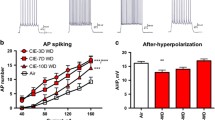Summary
Recent electrophysiological and biochemical studies suggest that ethanol interferes with excitatory amino acid (EAA) neurotransmission. Here, we present electrophysiological evidence that, following cessation of a chronic ethanol treatment, noradrenergic locus coeruleus (LC) neurons display hyperactivity at the same time as a specifically enhanced sensitivity to microiontophoretically applied NMDA or quisqualate. Furthermore, after chronic ethanol treatment, but not before, the NMDA receptor antagonist MK 801 (0.3–2.4 mg/kg, i.v.) dose-dependently inhibited the firing of the LC neurons. Our data indicate that an up-regulation of EAA receptors located on LC neurons accounts for the changes in LC firing in ethanol-treated rats. We propose that activation of the LC contributes to the clinical signs of the ethanol abstinence reaction and that EAA antagonists may be beneficial therapeutically for its treatment.
Similar content being viewed by others
References
Aghajanian GK, Cedarbaum JM, Wang RY (1977) Evidence for norepinephrine-mediated collateral inhibition of locus coeruleus neurons. Brain Res 131:570–577
Aghajanian GK (1978) Tolerance of locus coeruleus neurons to morphine and suppression of withdrawal responses by clonidine. Nature 276:186–187
Ahtee L, Svartström-Fraser M (1975) Effects of ethanol dependence and withdrawal on the catecholamines in the rat brain and heart. Acta Pharmacol Toxicol 36:289–298
Aston-Jones G, Ennis M, Pieribone VA, Nickell WT, Shipley MT (1986) The brain nucleus locus coerulcus: Restricted afferent control of a broad efferent network. Science 234:734–737
Chen Z, Engberg G (1989) The rat nucleus paragigantocellularis as a relay station to mediate peripherally induced central effects of nicotine. Neurosci Lett 101:67–71
Engberg G, Elam M, Svensson TH (1982) Clonidine withdrawal: activation of brain noradrenergic neurons with specifically reduced alpha-2-receptor sensitivity. Life Sci 30:235–243
Engberg G, Hajds M (1992) Ethanol attenuates the response of locus coeruleus neurons to excitatory amino acid agonists in vivo. Naunyn-Schmiedeberg's Arch Pharmacol 345:222–226
Ennis M, Aston-Jones G (1988) Activation of locus coeruleus neurons from the nucleus paragigantocellularis: a new excitatory amino acid pathway in the brain. J Neurosci 8:3644–3657
Gonon FG (1988) Nonlinear relationship between impulse flow and dopamine release by rat midbrain dopaminergic neurons as studied by in vivo electrochemistry. Neuroscience 24:19–28
Gonzales RA, Woodward JJ (1990) Ethanol inhibits N-methyl-D-aspartate-stimulated [3H]norepinephrine release from rat cortical slices. J Pharmacol Exp Ther 253:1138–1144
Göthert M, Fink K (1989) Inhibition of N-methyl-D-aspartate (NMDA)- and L glutamate-induced noradrenaline and acetylcholine release in the brain by ethanol. Naunyn-Schmiedeberg's Arch Pharmacol 340:516–521
Grant KA, Valverius P, Hudspith M, Tabakoff B (1990) Ethanol withdrawal seizures and the NMDA receptor complex. Eur J Pharmac 176:289–296
Hajös M, Engberg G (1990) A role of excitatory amino acids in the activation of locus coeruleus neurons following cutaneous thermal stimuli. Brain Res 521:325–328
Hoffman PL, Rabe CS, Grant KA, Valverius P, Hudspith M, Tabakoff B (1990) Ethanol and the NMDA receptor. Alcohol 7:229–231
Hunt WA, Majchrowicz EJ (1974) Alterations in the turnover of the brain norepinephrine and dopamine in alcohol-dependent rats. J Neurochem 23:549–552
Karoum F, Wyatt RJ, Majchrowicz E (1976) Brain concentrations of biogenic amine metabolites in acutely treated and ethanol-dependent rats. Br J Pharmacol 56:403–411
Liljequist S, Ekman A, Snape B, Söderpalm B, Engel J (1990) Environment-dependent effects of ethanol on DOPAC and HVA in various brain regions of ethanol-tolerant rats. Psychopharmacology 102:319–324
Lima-Landman MTR, Albuquerque EX (1989) Ethanol potentiates and blocks NMDA-activated single-channel currents in rat hippocampal pyramidal cells. FEBS Lett 247:61–67
Lovinger DM, White G, Weight FF (1989) Ethanol inhibits NMDA-activated ion current in hippocampal neurons. Science 243:1721–1724
Lovinger DM, White G, Weight FF (1990) NMDA receptor-mediated synaptic excitation selectively inhibited by ethanol in hippocampal slice from adult rats. J Neurosci 10:1372–1379
Morrisett RA, Rezvani AH, Overstreet D, Janowsky DS, Wilson WA, Swartzwelder HS (1990) MK-801 potently inhibits alcohol withdrawal seizures in rats. Eur J Pharmacol 176:103–105
Rasmussen K, Aghajanian GK (1989) Withdrawal-induced activation of locus coeruleus neurons in opiate-dependent rats: attenuation by lesions of the nucleus paragigantocellularis. Brain Res 505:346–350
Stone TW (1985) Microiontophoresis and pressure ejection. In: Smith AD (ed) IBRO handbook series: Methods in the neuroscience, vol 8. John Wiley, New York, pp 1–214
Svensson TH (1986) Clonidine in abstinence reactions: basic mechanisms. Acta Psychiatr Scand [Suppl] 327:19–42
Svensson TH (1987) Peripheral, autonomic regulation of locus coeruleus noradrenergic neurons in the brain: putative implications for psychiatry and psychopharmacology. Psychopharmacology 92:1–8
Svensson TH, Bunney BS, Aghajanian GK (1975) Inhibition of both noradrenergic and serotonergic neurons by the alpha-adrenergic agonist clonidine. Brain Res 92:291–306
Tung C-S, Ugedo L, Grenhoff J, Engberg G, Svensson TH (1989) Peripheral induction of burst firing in locus coeruleus neurons by nicotine mediated via excitatory amino acids. Synapse 4:313–318
Wålinder J, Balldin J, Bokström K, Karlsson I, Lundström B (1981) Clonidine suppression of the alcohol withdrawal syndrome. Drug Alcohol Depend 8:345–348
Watkins JC, Evans RH (1981) Excitatory amino acid transmitters. Ann Rev Pharmacol Toxicol 21:165–204
Watkins JC, Krogsgaard-Larsen P, Honoré T (1990) Structure-activity relationships in the development of excitatory amino acid receptor agonists and competitive antagonists. Trends Pharmacol Sci 11:25–33
Werner G, Mountcastle VB (1963) The variability of central neural activity in a sensory system and its implication for central reflection of sensory events. J Neurophysiol 26:958–978
Wilkins AJ, Jenkins WJ, Steiner JA (1983) Efficacy of clonidine in treatment of alcohol withdrawal state. Psychopharmacology 81:78–80
Wong EHF, Kemp JA, Priestley T, Knight AR, Woodruf GN, Iversen LL (1986) The anticonvulsant MK-801 is a potent N-methyl-D-aspartate antagonist. Proc Natl Acad Sci USA 83:7104–7108 (1986)
Author information
Authors and Affiliations
Additional information
Correspondence to G. Engberg at the above address
Rights and permissions
About this article
Cite this article
Engberg, G., Hajós, M. Alcohol withdrawal reaction as a result of adaptive changes of excitatory amino acid receptors. Naunyn-Schmiedeberg's Arch Pharmacol 346, 437–441 (1992). https://doi.org/10.1007/BF00171087
Received:
Accepted:
Issue Date:
DOI: https://doi.org/10.1007/BF00171087




